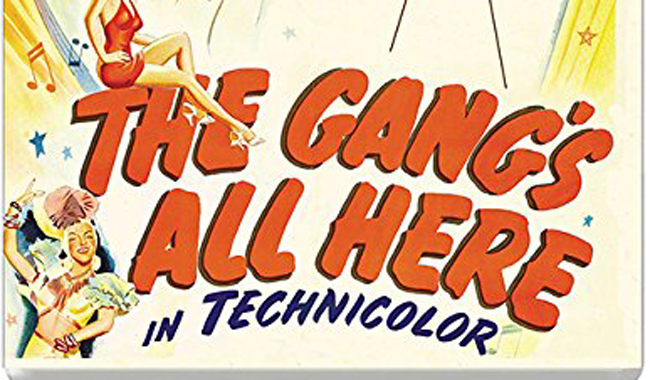
The Gang’s All Here Review
 The Gang’s All Here is a piece of fluff but the amazing and stunning Technicolor in HD Blu-ray and Carmen Miranda’s costumes and set pieces should be enough to distract the viewer from any weak storyline. Directed by the irrepressible Busby Berkeley, this light wartime propaganda musical does contain some amazing sequences.
The Gang’s All Here is a piece of fluff but the amazing and stunning Technicolor in HD Blu-ray and Carmen Miranda’s costumes and set pieces should be enough to distract the viewer from any weak storyline. Directed by the irrepressible Busby Berkeley, this light wartime propaganda musical does contain some amazing sequences.
The story as such is about a GI on furlough and is waiting to be stationed out West somewhere (he doesn’t realise it yet, but is in fact the Pacific) and spends a night on the town in New York. He meets a blonde chorus line girl (Alice Faye) who is charging a dime a dance (something girls would do to entertain the troops in the clubs; prostitution?) He pursues her all evening until he finally seduces her late night on the Staten Island Ferry. Here is an example of suspending disbelief. I can’t imagine the Staten Island Ferry was any more glamorous in 1943 than it is today but the film makes it look like an ocean moonlit cruise through Caribbean islands rather than the Hudson Bay. He kisses her goodnight, nibbles her ear and arranges to meet her under the clock at Grand Central Station where he says goodbye to her. She is lovelorn after he departs but gets on with her dancing career. However, she soon learns that he is engaged to one of the other dancers in her troop and is unsure how to approach this delicate matter thinking that maybe there is some mix up or that he is like all the other fellas.
The highlights from the films are the musical numbers, particularly those sung by Miranda. The most famous of all and the most stunning is the famous ‘The Lady in the Tutti-Frutti Hat’, a magical classic Berkeley constructed musical fantasia almost 8 minutes long. This has Miranda in her fruity bowl of fruit on her head, some dancing bananas and a finale of an explosion of bananas on her head. Crazy and surreal. This recalls the classic Berkeley moments from some of his signature musicals of the early 1930s: Footlight Parade, 42nd Street, Dames and the Gold Digger films. This time though they are not in sparkling silvery black and white but in sparkling Technicolor. The look of the normal kaleidoscopic aerial views of the synchronised dancers has the look of an opening flower painting like some kind of erotic Georgia O’Keefe painting and do add an extra dimension to his films. But sadly this is let down by a lame plot, despite the eccentric larger than life performances by the Brazilian Carmen Miranda and older character actress Charlotte Greenwood as the crazy society lady, Mrs. Peyton Potter at who’s house and pool party the show is being put on.
Produced by 20th Century Fox these Technicolor musical productions were made during World War Two to raise moral and openly raise money for war bonds. These films often included such stars as Betty Grable, probably the most famous pin-up of the war years (along with Rita Hayworth) and, like The Gangs All Here were usually fluffy musicals with a thin plot and plenty of leggy numbers. They were made in contrast to the MGM musicals, but they had Arthur Freed at the production helm and appeared glossier and had more talent such as the likes of Fred Astaire and later Gene Kelly. Never the less it’s great to see this film in a way not seen for many years and is an interesting addition to the Eureka! Masters of Cinema series. Ultimately though this is a tribute to Busby Berkeley and a culmination of his crazy imagination – no stage production could ever stage something as elaborate or eccentric as the numbers that appear in this film. Check out the oversized Eugene Palette trying to sing as a disconnected head in the crazy finale number. The extras on the disc include a deleted scene with a comic quiz with the sergeant being grilled about famous faces on the stage and a fascinating documentary about this film in the context of Berkeley’s career. Despite this being a piece of fun it is clear why the scene was omitted.
Chris Hick
